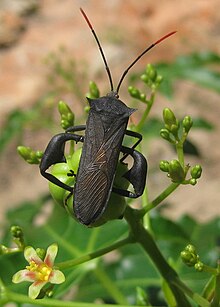Loading AI tools
Family of insects From Wikipedia, the free encyclopedia
Coreidae is a large family of predominantly sap-sucking insects in the Hemipteran suborder Heteroptera.[1] The name "Coreidae" derives from the genus Coreus, which derives from the Ancient Greek κόρις (kóris) meaning bedbug.[2]
| Coreidae Temporal range: | |
|---|---|
 | |
| Anoplocnemis curvipes with typical enlarged hind femora | |
| Scientific classification | |
| Domain: | Eukaryota |
| Kingdom: | Animalia |
| Phylum: | Arthropoda |
| Class: | Insecta |
| Order: | Hemiptera |
| Suborder: | Heteroptera |
| Superfamily: | Coreoidea |
| Family: | Coreidae Leach, 1815 |
| Subfamilies | |
| |
As a family, the Coreidae are cosmopolitan, but most of the species are tropical or subtropical.
The common names of the Coreidae vary regionally. Leaf-footed bug refers to leaf-like expansions on the legs of some species, generally on the hind tibiae. In North America, the pest status of species such as Anasa tristis on squash plants and other cucurbits gave rise to the name squash bugs.[3][4] The Coreidae are called twig-wilters or tip-wilters in parts of Africa and Australia because many species feed on young twigs, injecting enzymes that macerate the tissues of the growing tips and cause them to wilt abruptly.[5][6]
The Coreidae commonly are oval-shaped, with antennae composed of four segments, numerous veins in the membrane of the fore wings, and externally visible repugnatorial stink glands. They vary in size from 7 to 45 mm long, which implies that the family includes some of the biggest species of Heteroptera. The body shape is quite variable; some species are broadly oval, others are elongated with parallel sides, and a few are slender. Many species with the "leaf-footed" tibiae are very slender with conspicuous expansions of the hind tibiae, but some robust species also have decided expansions. Some species are covered with spines and tubercles.[7] As an example of these, the tribe Phyllomorphini Mulsant & Rey, 1870, are strikingly aberrant, with thin legs, spiny bristles, and laciniate outlines and adornments.
Many of the more robust species have grossly enlarged, thickened, and bowed hind femora armed with spikes on the inner edge, and with hind tibiae to match, though the enlargement of the tibiae is less exaggerated.[1][3]
In the nymphs, the openings of the two repugnatorial stink glands of the Coreidae are visible as two projections or spots on the medial line of the dorsal surface of the abdomen, one at the anterior and one at the posterior edge of the fifth abdominal tergite above the glands inside. During the final ecdysis, the anatomy is rearranged and the glands end up in the metathorax, opening laterally through ostioles between the mesothoracic and metathoracic pleura.[8]
The Coreidae generally feed on the sap of plants. Some species reportedly are actively carnivorous,[9] but material evidence is lacking, and in the field, some are easy to confuse with some species of the Reduviidae, so doubt has been cast on the veracity of the claims.[10]
Some Coreidae, such as Phyllomorpha laciniata, exhibit parental care by carrying their eggs. This behaviour significantly improves the eggs' chances of avoiding the attacks of parasitoids.[11]
The Coreidae are placed in the order Hemiptera and closely related to the families Alydidae, Hyocephalidae, Rhopalidae, and Stenocephalidae. Together, these five families form the superfamily Coreoidea. The family is large, with more than 1,900 species in over 270 genera.[7]
Most taxonomists dealing with the Coreidae divide the family into three or four subfamilies. Numerous tribes of the Coreinae have previously been proposed for elevation to subfamily rank, for example, the Agriopocorini, Colpurini, Phyllomorphini, and Procamptini, but the only one of these changes that at least a significant minority of researchers accepted is the elevation of the Agriopocorinae, and more recent reviews tend to treat them as a tribe again, recognizing only the three subfamilies known by 1867 plus Hydarinae.
The family has been demonstrated to be non-monophyletic, as Hydarinae and Pseudophloeinae are more closely related to Alydidae than to other coreids.[12]
The following genera are included in the family Coreidae:
Coreinae Leach, 1815
|
Hydarinae Stål, 1873
|
Meropachyinae Stål, 1867
|
Pseudophloeinae Stål, 1867
|
Seamless Wikipedia browsing. On steroids.
Every time you click a link to Wikipedia, Wiktionary or Wikiquote in your browser's search results, it will show the modern Wikiwand interface.
Wikiwand extension is a five stars, simple, with minimum permission required to keep your browsing private, safe and transparent.